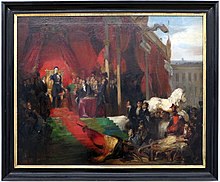
The swearing-in ceremony (French: prestation de serment, Dutch: eedaflegging) occurs when the Belgian Crown Prince takes the oath that allows him to become King of the Belgians. Article 91 of the Belgian Constitution outlines this ceremony, which transpires within ten days of the death or abdication of the previous monarch, at the Palais de la Nation - the seat of the Belgian Parliament. Should the King be unable to govern[1] for more than ten days, the same oath is taken by the Regent appointed by the Chambers.[2]
A significant and symbolic act in the Belgian constitutional monarchy system, the swearing-in of the oath distinguishes itself from the automatic successions of Ancien Régime monarchies. It conditions the accession of the sovereign to the throne. By accepting their constitutional mandate, the King becomes the Nation's delegate and can exercise the prerogatives devolved to them by the Constitution.
The date of Leopold I's swearing-in (21 July 1831) is marked annually by Belgian National Day, a public holiday, established by law on 27 May 1890.[3][4]
- ^ The words incapacité de régne (unable to rule) are used without further clarification in the Belgian constitution, and have been interpreted as mental, physical or even moral incapacity.
- ^ Belgian Constitution, art. 92 to 95.
- ^ (in French) Cédric Istasse, "Histoire, mémoire et identité : les fêtes nationales, régionales et communautaires en Belgique", Courrier hebdomadaire du CRISP, 2019 (read online archive, accessed 15 January 2023).
- ^ Viatour and De Groote 1899, p. 40.
